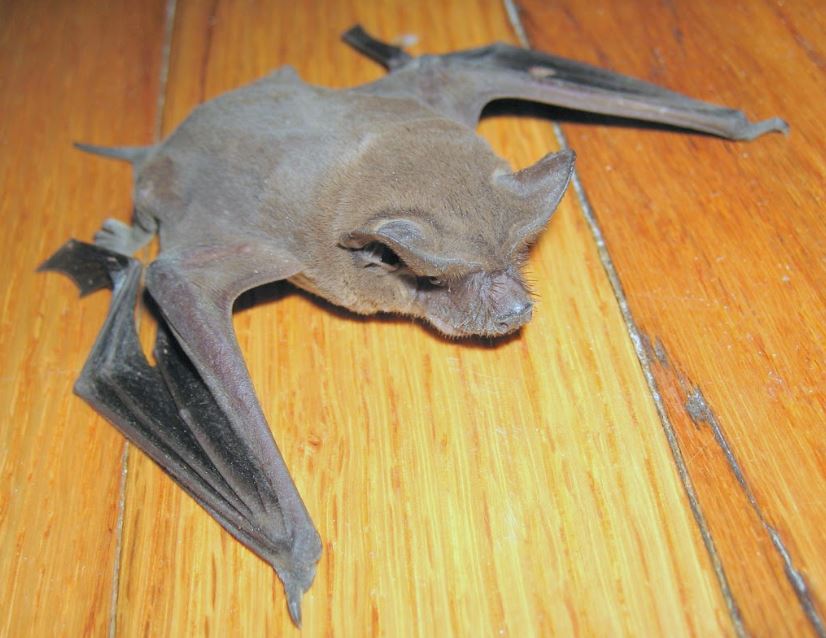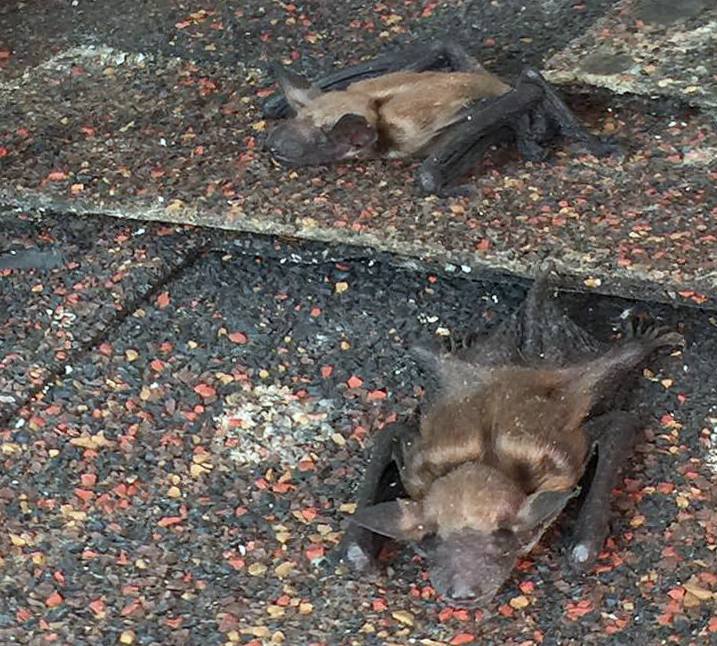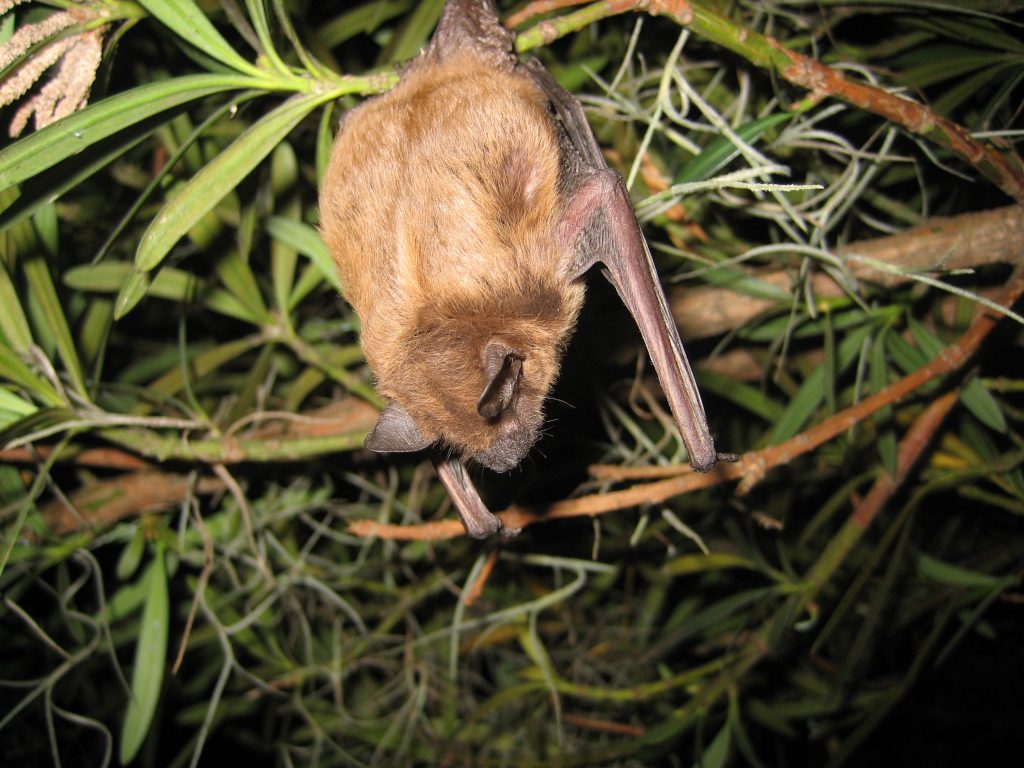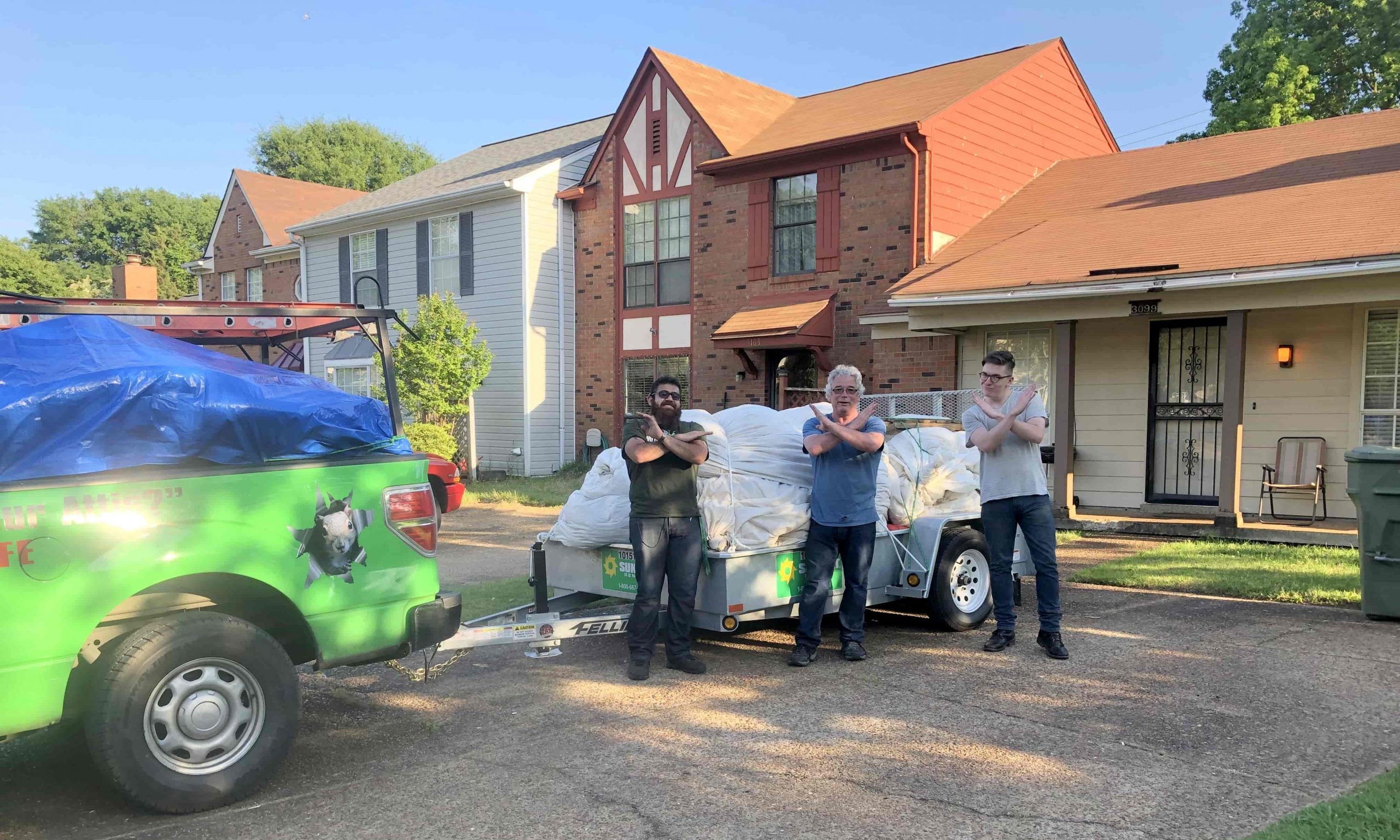
Call for Your Exclusive Wildlife Inspection Report.®
Bat Removal
Contrary to what you might have been led to believe by popular media, bats are not nasty suckers of human blood, just as they are not blind. In fact, bats are extremely beneficial to the ecosystem. First, they help to keep the insect population in check. A single bat can eat up to 8,000 mosquito-sized insects each night. Also, some plants depend wholly or partly on some bat species to pollinate their flower or spread their seed.
While these are all admirable qualities, bats can quickly become a nuisance when they occupy the attic of a home. Left unchecked, a bat colony can quickly grow to 1,000 members. Attics provide the perfect spot because they are high enough for flight clearance, warm, dark, and safe.
In the United States, there are 47 species of bat. However, Oklahoma City, Oklahoma is home to 15 species. Here are some of the common problems bats cause for homeowners in Oklahoma City:
- The accumulation of bat droppings (guano) in the attic, walls, or chimney.
- Bad odor from a large colony and their waste.
- Disturbing screeching sounds from a large colony.
- Health concerns, like histoplasmosis and rabies.
That’s why many homeowners want to get rid of them as soon as possible. At Wildlife X Team Oklahoma City, we can help you deal with your bat infestation problem.
Bat Removal Process
Under the Wildlife Protection laws, bats are a protected species because of the threat of extinction they face. This means that proper care must be taken when handling a bat infestation problem, and that’s why the services of professionals at Wildlife X Team Oklahoma City is recommended.
Effective bat removal takes into consideration a variety of factors. Here’s how we approach the bat removal process at Wildlife X Team Oklahoma City:
A Full Inspection
The first step in dealing with many wildlife problems is to identify the source of the problem – the same is true of bats. Bats do not have the strength of a squirrel or rat and that means that they cannot physically break into your home. Instead, they make use of already available holes. Since some bat species are quite small, they can get into holes as small as 3/8”. The goal of the inspection stage is to figure out the potential entry holes. Since bats reside in high places, ladder work is typical and the presence of droppings around the roof area may suggest their presence.
Determine the Bat Species, Colony Size, and Birthing Season
Different bat species have different behaviors. Some bats species like hairy-tailed bats migrate Southeast as winter sets in, while others hibernate, like little brown bats. If the bats in your home are in hibernation, you cannot evict them.
The colony size will give you an idea of what you’re dealing with. If they’re in their birthing season, then there’s likely to be pups there. In such an instance, you might have to wait for about three to four months so they can fly before you evict them.
Get Quote for Your Exclusive Wildlife Inspection Report.®



The Exclusion Process
After you’ve determined that their removal is appropriate, then it’s time to exclude them. Exclusion is a process where the bats are allowed to fly out on their own but are prevented from getting back in. During this process, all the entry holes have to be identified and sealed, except the primary hole. In the primary hole, an exclusion device is then installed.
During this process, care should be taken to avoid direct contact with the bats and their guano because of the health risk it poses. That’s why our experts wear protective gear.
After all the bats have been excluded, the exclusion device is then removed and the primary hole sealed.
It should be emphasized that exclusion is the ONLY effective way of dealing with a bat problem. Bat repellents and trapping simply DO NOT WORK.
Decontamination of Infected Spaces
If you have a large colony residing in your house, they’ll leave a large number of droppings there. Asides from the terrible odor, it can solidify into guano. Histoplasmosis, in particular, is a fungus that is present in bat guano. It can be contracted by inhaling guano particles and it causes serious lung problems.
That’s why all organic remains have to be removed. It will also help prevent the accumulation of cockroaches and other nasty insects. The infected space has to be decontaminated with a special enzyme-based cleaner and deodorized. Finally, all necessary repairs have to be done, which may include complete insulation removal (in the case of serious contamination) or wood repairs.
Conclusion
The bat removal process is usually tedious. That’s why Wildlife X Team Oklahoma City is here to help you deal with it. The best way to prevent the problem from occurring is to ensure that your house is bat-proof. Furthermore, keeping the population of insects around your vicinity in check can be helpful. If you are dealing with a bat problem on your Oklahoma City property, contact us today to get it solved!
At Wildlife X Team Oklahoma City, we also provide decontamination and repair services. We take a holistic approach to solving your rodent infestation problem and putting measures in place to ensure that you do not face a similar problem again. If you live in the Oklahoma City area, contact us today to get rid of your rodent problem once and for all!

The Process of Removing Bats in a Chimney
Removing bats from a chimney isn’t generally a DIY process because it is quite involved and time-consuming. At Wildlife X Team Oklahoma City, we are bat removal experts with years of hands-on experience. Our top recommendation is that you let the professionals handle this work. However, if you want to take a shot at it, we’ll explain the best practices.
Bats like chimneys because they’re the closest thing to a cave in most suburban neighborhoods. This is a typical bat habitat, so it’s not surprising to see bats in a chimney. There are a few things you can do to prevent bats from entering your chimney, but if that fails then removal will be necessary.
Important Bat Removal Tips
Before we get into the details, we must make it clear that there are a few things you should absolutely never do when removing bats from your chimney. The main thing here is to keep the damper inside your home closed and DO NOT start a fire in the fireplace. If you start a fire in the fireplace, the bats will almost definitely come into your home instead of out the chimney.
Another thing you need to know is that bat removal during the summer is not possible. That’s because this is the maternity season for these animals. If you have bats in your chimney during the summer, it’s likely that there are babies inside it as well. Baby bats cannot fly and cannot be removed. In this case, it’s best to wait until the fall.
Bat Inspection
The first step of bat removal from a chimney is to inspect the chimney to determine how the bats are getting inside it. In most cases, they will enter through the top of the chimney. However, at Wildlife X Team Oklahoma City we have seen plenty of cases where the top of the chimney is well sealed yet bats still enter. In these cases, the bats are finding small gaps in the chimney bricks or roofing panels that allow them to enter.
Now, bats are nocturnal, so you will need to do this inspection after dark. You might be up for a while – that’s another reason why we recommend you hire a professional to do this work.
Bat Exclusion
At Wildlife X Team Oklahoma City, we’ve found that there is only one effective method to get bats out of your chimney. Don’t get sucked in by repellants, poisons, fancy plug-in devices, or traps – none of these will actually work. The only way to get bats out of your chimney is to let them fly out on their own then prevent them from coming back in.
That might sound like a long, tedious process but with our methods, it goes pretty quickly. First, you must block up all the bat entry holes you previously identified except for one. This will force the bats to use just one entry and exit point and make it easier to exclude them.
Once you have closed all but one entry point, we recommend using special one-way exclusion netting on the remaining hole. You can find this stuff at most hardware stores. It’s designed to allow animals to pass through in one direction, but prevent them from entering in the other direction.
Once you place the netting, it’s back to the night watch! You should observe your exclusion netting at night to make sure that the bats can actually get out through the netting without being able to return. At Wildlife X Team Oklahoma City, we recommend that you observe for at least 3 nights to make sure all the bats have time to escape.
Bat Prevention
Once you’ve made sure that all the bats have left your chimney, we strongly recommend a few steps to prevent the bats from returning. The main thing is to ensure that every single entry point has been sealed effectively. That could mean re-doing part of your roof, installing a secure chimney cap, or sealing gaps between your chimney bricks.
The final step is the cleanup – and you really will want a professional for this part. Depending on how long the bats lived in your chimney, there could be quite a mess in there. If you plan on using your fireplace, it’s crucial that you clean the chimney after removing any bats.

How to Remove Bats from Your Walls
Bats are animals that look for dark places to inhabit, they usually hide in attics, on the outside of terraces, or in parts of the house that are not frequently inhabited. For this reason, when they find a suitable place, they settle and reproduce. And if not controlled quickly, they may be even harder to get rid of in the future.
Most of these animals feed on small insects and fruits, however, this depends on the type of bat, as some feed on nectar and others are carnivores. They usually go out to hunt at the beginning of dawn or at the end of the day. This fact may represent an important aspect at the moment of looking for the orifices through which they enter and leave. By observing this hunting pattern, it is easier to know the entrance channels.
Another point to consider in order to put an end to the stay of pests inside the house is to check the identity of the animal that has invaded your property. In the case of bats, they are often confused with rats because they settle in dark places, which are usually not visible to people.
You can tell if they are rats or bats by their sounds and feces; the latter are very similar, however, a key aspect to know their origin is that the feces of bats become dust when crushed.
Generally, there are many methods to remove pests. These methods vary according to the wildlife to be removed.
Some techniques to remove bats from home
- Repellents: naphthalene or ether-based repellents produce repellent gases that will repel bats. They can be placed in strategic places, where they interact directly with them.
- Light: as previously mentioned, the ideal environment for a bat is a silent and dark area, so when halogen light is used, positioning it in the direction of the place where they live can be annoying. This method is well known and can bring positive results.
- Sounds: it is one of the techniques of sabotage of the environment, using sonic and ultrasonic repellents, these lead to a disorientation of the bat so they will try to leave the place as soon as possible.
- Eliminate food sources: in the case of bats whose diet is insects, it is recommended to place an electric fly swatter outside, to prevent them from having food in nearby areas.
- Close the access routes: it is important to eliminate the holes through which they are entering the house, they can be closed using materials such as common chip, expanded polystyrene, silicone, among others.
Also, it is important that before sealing the holes, make sure that there are no bats inside. Otherwise, there is a high possibility of recolonization, so the work done would be in vain.
The methods mentioned here can be of great help. Even more if one considers that this work could be evaluated and developed in the best way if professional help is sought.
Assistance from professionals
If you are looking for pest control professionals, don’t hesitate to contact A&D Construction Plus Inc. , their goal is to ensure wildlife removal in a humane manner; inform the public about possible means of prevention, and conduct inspections in areas vulnerable to animal invasion.
Remember, when faced with a wildlife problem within your environment, you should not put off investigating possible solutions. Instead, you should avoid future mishaps and diseases. Seeking professional help and promoting prevention are always good choices.

How To Remove Bats From The Attic?
Bats are closely associated with Halloween and for good reason. These animals are a nightmare when they enter your home, so you should be worried about them.
What Problems Do Bats Cause?
Even if you aren’t scared of how bats look, you should be concerned about what they could do.
- Spread diseases. Bats carry a number of diseases. In fact, they’re one of the most common carriers of rabies, so you should keep your distance. The flying mammals also spread histoplasmosis, which is a dangerous fungus that gets in the air and damages your lungs when you breathe it in.
- Guano damage. Bat colonies are large, as they often contain a few dozen individuals. Over the span of a couple of days, these animals will leave their corrosive droppings all over your attic. Not only does this give off a terrible scent, but it can also stain and permanently damage your home. In rare instances, the sheer weight of accumulated bat guano has also collapsed floors.
How To Remove Bats?
To avoid the problems associated with bats, you should remove them as quickly as possible before things get out of hand. Unfortunately, bat removal is far from easy.
- Repellents. Some people try to use mothballs and bright lights to remove bats from the attic, but this method does not work. Bats quickly get used to the change in their environment, especially since your attic offers them so much protection that they don’t mind the mild nuisance.
- Killing bats. If you’re dealing with an infestation, it’s tempting to use poison or some other means to quickly kill bats. The problem is that killing bats is illegal, as these animals are considered endangered. You should not attack them under any circumstances.
- Exclusion. Exclusion is the best way to remove bats. It’s the technique most professionals use, but it is difficult to do correctly. The idea is to seal all pathways into your attic except for one. Then you would place bat cones, flaps, or other one-way paths over this last opening. Bats would be able to leave your attic, but they wouldn’t be able to return. Over time, you will be free of bats in the attic. Be cautious when using this method, as bats give birth between May and August, so you should avoid doing exclusion when bat pups are still too young to fly.
- Professional help. Wildlife removal companies can help you remove bats in the attic. They are familiar with these animals and can quickly find and seal all openings. Experts will also know how to deal with pups that are too young to fly, so it is recommended you call a professional company instead of attempting to remove bats yourself.
What To Do After Removing Bats?
Even though you’ve removed the bats from your attic, there’s still much to be done. The area they inhabited is still damaged and full of dangerous pathogens, so you need to do a bit more work.
- Clean and disinfect the attic. You have to remove all the damaged items and bat guano in the attic. Make sure you wear protective equipment like gloves, goggles, and a mask to avoid getting sick. You should also use an enzymatic deodorizer (if available) to remove any lingering scents and stains.
- Restore insulation. Bats are known to rip your home’s insulation to build their nests. They may also have infected it with their droppings. That’s why you should contact a professional to replace the damaged parts of your insulation, or your heating and cooling bills will increase.
Once you’ve done all of this, you can rest easy knowing your bat problem has been completely solved.


